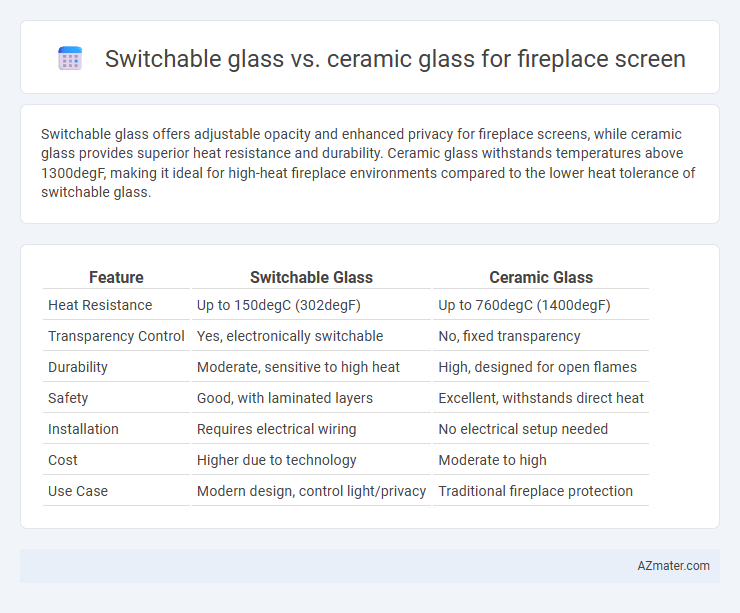Switchable glass offers adjustable opacity and enhanced privacy for fireplace screens, while ceramic glass provides superior heat resistance and durability. Ceramic glass withstands temperatures above 1300degF, making it ideal for high-heat fireplace environments compared to the lower heat tolerance of switchable glass.
Table of Comparison
| Feature | Switchable Glass | Ceramic Glass |
|---|---|---|
| Heat Resistance | Up to 150degC (302degF) | Up to 760degC (1400degF) |
| Transparency Control | Yes, electronically switchable | No, fixed transparency |
| Durability | Moderate, sensitive to high heat | High, designed for open flames |
| Safety | Good, with laminated layers | Excellent, withstands direct heat |
| Installation | Requires electrical wiring | No electrical setup needed |
| Cost | Higher due to technology | Moderate to high |
| Use Case | Modern design, control light/privacy | Traditional fireplace protection |
Introduction to Fireplace Glass Options
Switchable glass and ceramic glass are two prominent fireplace screen options offering distinct benefits for heat resistance and visual appeal. Switchable glass provides adjustable opacity through electrochromic technology, enhancing privacy and ambiance, while ceramic glass boasts superior heat tolerance up to 1400degF, ensuring durability and safety near open flames. Choosing between these materials depends on desired aesthetics, thermal performance, and functional control of light and visibility in fireplace design.
What is Switchable Glass?
Switchable glass, also known as smart glass, is a type of glass that changes from opaque to transparent when an electrical current is applied, offering privacy and style for fireplace screens. Unlike ceramic glass, which is heat-resistant and designed to withstand high temperatures without changing appearance, switchable glass allows dynamic control over light and visibility. This technology enhances fireplaces by combining modern aesthetics with functional adaptability, though it requires a power source and is typically used for decorative rather than direct heat exposure.
What is Ceramic Glass?
Ceramic glass used in fireplace screens is a highly durable, heat-resistant material capable of withstanding temperatures up to 1400degF (760degC), ensuring safety and efficiency while containing sparks and embers. Unlike switchable glass, which changes transparency through electrical currents, ceramic glass maintains a consistent, clear view of the fire with enhanced thermal insulation. Its resistance to thermal shock and physical impact makes ceramic glass the preferred choice for long-lasting fireplace protection.
Key Differences Between Switchable Glass and Ceramic Glass
Switchable glass for fireplace screens offers dynamic opacity control, allowing users to switch between transparent and opaque states for privacy and aesthetic flexibility, whereas ceramic glass is designed primarily for high thermal resistance and durability, withstanding direct exposure to flames and heat. Switchable glass incorporates liquid crystal technology requiring electrical power, making it less heat-resistant compared to ceramic glass, which is non-conductive and maintains structural integrity under extreme temperatures. Ceramic glass ensures safety and long-term performance in high-heat environments, while switchable glass emphasizes modern functionality and visual adaptability.
Heat Resistance Comparison
Switchable glass and ceramic glass differ significantly in heat resistance when used for fireplace screens. Ceramic glass withstands temperatures up to 1300degF (704degC) without deformation, making it ideal for intense and prolonged heat exposure. Switchable glass typically endures lower temperatures around 110degF to 150degF (43degC to 65degC), limiting its use in high-heat environments such as fireplaces.
Safety Features and Performance
Switchable glass offers advanced safety features by instantly changing from transparent to opaque, reducing glare and heat transmission while providing privacy and protection from sparks. Ceramic glass for fireplace screens withstands extremely high temperatures up to 1400degF, offering superior heat resistance and durability without deformation or cracking. Performance-wise, switchable glass enhances ambiance control, whereas ceramic glass excels in thermal insulation and long-term safety during continuous fireplace use.
Aesthetics and Design Flexibility
Switchable glass offers dynamic transparency control, allowing users to adjust opacity from clear to frosted, enhancing modern fireplace aesthetics with customizable privacy and ambient light settings. Ceramic glass stands out for its heat resistance and durability while maintaining a sleek, transparent appearance that complements minimalist designs and traditional hearths. Designers favor switchable glass for its adaptability in various lighting conditions, whereas ceramic glass provides consistent clarity and safety under high temperatures.
Energy Efficiency and Heat Transfer
Switchable glass offers dynamic control over transparency and solar heat gain, enhancing energy efficiency by reducing unwanted heat transfer in fireplace screens. Ceramic glass withstands higher temperatures and provides superior thermal insulation, minimizing heat loss and protecting surrounding areas. Both materials improve fireplace energy performance, but ceramic glass excels in heat resistance while switchable glass optimizes energy savings through adjustable transparency.
Cost and Maintenance Considerations
Switchable glass for fireplace screens typically costs 30-50% more than ceramic glass due to advanced technology integration, but offers the benefit of adjustable opacity for privacy and heat control. Ceramic glass, while more affordable and able to withstand temperatures up to 1400degF, requires less frequent replacement and simpler maintenance compared to the sensitive electronic components in switchable glass. Maintenance costs for switchable glass can be higher because of potential repairs to electrical systems, whereas ceramic glass mainly involves routine cleaning and occasional inspection for cracks.
Which Fireplace Glass is Right for You?
Switchable glass offers the advantage of adjustable opacity, allowing you to control privacy and light transmission in your fireplace screen, while ceramic glass provides exceptional heat resistance and durability for high-temperature environments. For those seeking a modern aesthetic with adaptable light filtering, switchable glass is ideal, whereas ceramic glass suits users prioritizing safety and long-term performance near intense flames. Understanding your fireplace's heat output and design preferences will help determine whether the thermal stability of ceramic glass or the innovative privacy features of switchable glass best meet your needs.

Infographic: Switchable glass vs Ceramic glass for Fireplace screen
 azmater.com
azmater.com